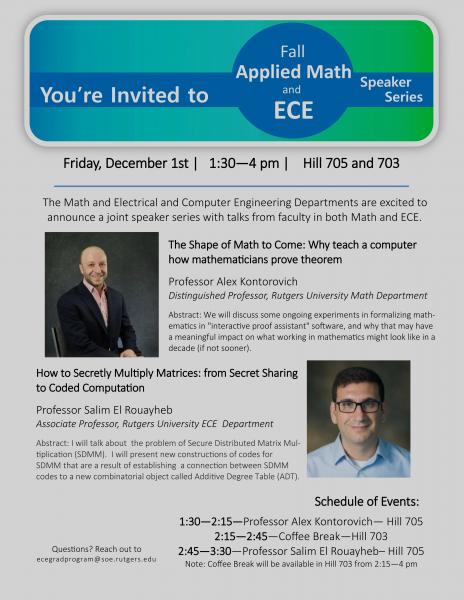Applied Math & ECE Speaker Series - Prof. Alex Kontorovich and Prof. Salim El Rouayheb

You're invited to the Applied Math and ECE Speaker Series.

You're invited to the Applied Math and ECE Speaker Series.
Associate Professor Anand Sarwate has received the Outstanding Engineering Faculty Award. The award was presented by Dean Alberto Cuitino and Department Chair Yingying Chen.
Since joining the Department of Electrical and Computer Engineering faculty in 2014, Anand Sarwate has established a reputation as a leading researcher in areas such as statistics, machine learning, information theory, distributed optimization and signal processing, and privacy-preserving data analysis. A recipient of the prestigious NSF CAREER award, he has received more than $6 million in funding from federal agencies including the NSF, NIH, PNNL, and DARPA for projects on which he is PI, as well as those on which he is a co-investigator. He has received a five-year renewal on an NIH subaward on a collaborative project for enabling decentralized analysis of neuroimaging data, as well as a research contract from the Pacific Northwest National Laboratories (PNNL) to develope deep neural networks for machine learning and artificial intelligence applications. His growing publishing portfolio addresses issues in various ECE subfields, while he serves as an associate editor and consulting editor for IEEE publications.
During the week of November 6 to 10, 2023, the ECE Department hosted about 900 undergraduate freshman students in 42 personalized sessions to teach them about the differences between electrical and computer engineering, the ECE curriculum, research in ECE, IEEE, career opportunities available in electrical and computer engineering fields, and the ECE BS/MS program. The goal of Intro to Engineering is to build rapport with freshmen who already decided on an ECE major, bring more interest to SOE students who don't know much about ECE, and gently persuade undecided freshmen to choose ECE as their major. They heard from faculty and staff and had the opportunity to apply what they learned in an ECE pumpkin printed circuit board (PCB)soldering activity.
We look forward to our incoming class of ECE students in the Fall of 2024!


The next ECE Colloquium is Wednesday, November 15th from 10:20 - 11:40 in COR - 101 and Dr. Scott Acton from the University of Virginia will be presenting. He will be presenting a talk titled, Visual Revolution: The Power of Images, Video, and Machine Learning. More information can be found in the flyer below.
Dean of Engineering Alberto Cuitino announced that ECE Professor Anand Sarwate will receive the Outstanding Engineering Faculty Award. The award is bestowed in recoginition of Prof. Sarwate's exceptional performance in teaching and outstanding research. The award recognizes the strong commitment and dedication of exceptional faculty. The award will be presented at 4 PM on Monday November 20th at the SOE Faculty Awards ceremony.
Congratulations on this excellent achievement!
On October 7th, 2023, two teams, "RATZ" and "RemIEEE," representing the Rutgers IEEE Micromouse division, participated in a Micromouse Competition held at the Massachusetts Institute of Technology (MIT). The primary objective of this competition was to construct a robotic "mouse" capable of autonomously navigating to the central 2x2 portion of a 16x16 maze in the shortest time possible. The event was organized by IEEE Region 1 and was hosted as a part of the IEEE MIT Undergraduate Research Technology Conference.
Before the official competition commenced, teams were granted the opportunity to conduct test runs with their robot mice and make any necessary adjustments. Subsequently, all participating teams gathered in a lecture hall to provide brief presentations about the design and functionality of their robotic creations.
During the official competition, each team was allotted 10 minutes to make attempts with their robot mice. The starting point for each mouse was the bottom-left corner of the maze, and if teams needed to reset their runs, they were required to place their mice back in this initial position. Judges were responsible for monitoring the remaining time for each team and assessing how close each team's mouse came to reaching the center of the maze. As none of the mouse robots successfully reached the maze's center, the rankings were determined by the proximity of each mouse to the center rather than the time taken. Team RATZ secured first place by coming closest to the center of the maze, while team RemIEEE claimed third place for having the third closest distance to the center.
ECE Students,
Learn how ECE Undergraduate Students can accelerate their careers by completing a Master’s degree in as little as one year!
